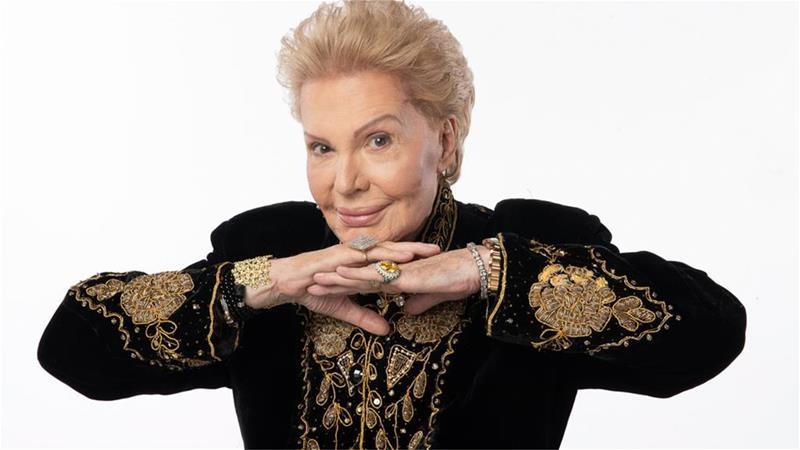Cristina Costantini’s first feature documentary, “Science Fair,” won audience awards at both the Sundance and SXSW Film Festivals in 2018, as well as an Emmy and Critics’ Choice Award for Best First Time Director. As an investigative journalist, Costantini covered detention centers, sex trafficking, and the opioid epidemic. Her investigative work has been recognized with a GLAAD Media Award and an Alfred I. duPont-Columbia University Award.
“Mucho Mucho Amor” premiered at the 2020 Sundance Film Festival on January 24. The film is co-directed by Kareem Tabsch.
W&H: Describe the film for us in your own words.
CC: Rarely do we get to meet our heroes, but this documentary was a dream come true for me. Raised in the sugar cane fields of Puerto Rico, Walter Mercado grew up to become a gender non-conforming, cape-wearing psychic whose televised horoscopes reached 120 million Latinx viewers a day for 30 years before he mysteriously disappeared.
At his peak, Walter was the world’s most famous astrologer. We had the great privilege to follow him on his journey to resurrect a faded legacy.
W&H: What drew you to this story?
CC: Like millions in the U.S. and around the world, I grew up watching Walter as a kid with my abuelita. Even then, I was aware that Walter was light-years ahead of his time. He looked like nothing else I had ever seen before and his message of love and peace resonated with me deeply.
As an adult, I started to wonder what happened to Walter. I became obsessed with the apparent contradiction that this androgynous person in glitzy capes was able to become a superstar in one of the most homophobic cultures in the world. And I was puzzled by his mysterious disappearance from the public eye.
In the process of trying to figure out where Walter went, I found two other filmmakers also captivated by the idea of making a film about him: Kareem Tabsch, my co-director, and Alex Fumero, the producer of the film. I spoke once on the phone before deciding that the three of us would team up to tell the story.
As Walter would say, “according to the stars, it was perfect.”
W&H: What do you want people to think about when they are leaving the theater?
CC: Walter’s life’s work was to promote harmony and love. At a time when our world is governed by hatred and forces of division, we need Walter and his message more than ever.
I hope people leave the theater filled with Walter’s energy and take away this idea that we’d all be better off if we showed a bit more love and compassion to one another.
W&H: What was the biggest challenge in making the film?
CC: Walter has been in front of a camera for over 50 years. I’ve never worked with someone who is so so media trained and so aware of where the camera is in every moment. Trying to capture his true essence, for this reason, was one of our biggest challenges.
Walter is a master of evading questions he’s not interested in answering and also very vain — to the extent that we never were allowed to film with him without at least a base layer of makeup on.
Despite these challenges, we grew very close with Walter and his family and friends over the two years of filming for the movie. With time, we were able to gain access to the man behind the cape.
W&H: How did you get your film funded? Share some insights into how you got the film made.
CC: Our initial financing for the film came from ArtesMiami, Topic Studios, and XTR.
Netflix acquired the project during the late stages of the edit and really helped us finish the film.
W&H: What inspired you to become a filmmaker?
CC: I think there’s no better way to create compassion than telling someone a story. For me, documentaries are the best tool we have to foster empathy. I’ve always felt somewhere in the middle of worlds that didn’t quite understand each other; I grew up in Milwaukee, Wisconsin, one of the most racially and economically segregated cities in the country. My dad is an immigrant. My mom is not. There are lots of differing political views within my own family. But I am sure that stories have the power to bridge all sorts of divides.
Making documentaries, to me, is the best way I’ve found to share an experience I know deeply with a group of people who don’t know it.
My first film, “Science Fair,” came out of my own experiences as a science fair kid and a necessity to share that beautiful little world with more people.
For me, “Mucho Mucho Amor” is also a vehicle to bring Walter to more people, while also celebrating an icon for a group of people who often don’t see themselves depicted in film.
W&H: What’s the best and worst advice you’ve received?
CC: The worst advice first. With this film in particular, I was told by a number of executives and agents that a “crossover documentary” just wouldn’t work. I’ve been told numerous times that this is only a Latino thing, that there wasn’t a way for non-Latinos to connect with our story, and that we wouldn’t find the money we wanted to make the film for those reasons.
Thanks to some wonderful executives at Netflix and some very smart sales agents at Cinetic Media, we were able to get the thing funded and finished. I think our job as documentary filmmakers isn’t to just talk to ourselves, but to reach outside and share stories with people who aren’t like us. Plus, sequined capes are definitely universal.
The best advice I’ve ever been given is from one of my best friends and colleagues, Mariana van Zeller. It’s simple — don’t work with assholes.







